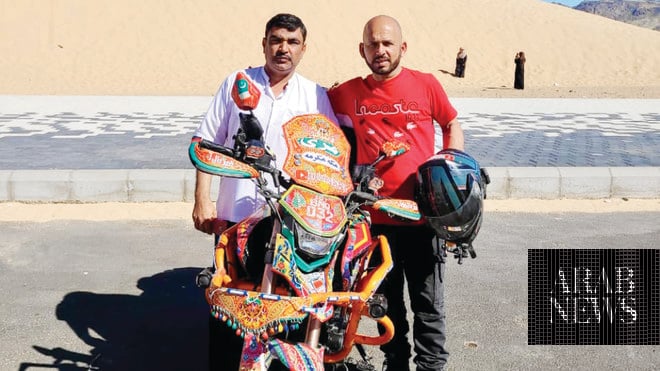
Artist’s street graffiti seeks to call out politicians and celebrities for their behavior
NEW DELHI: Mumbai street artist Tyler follows no one on his social media accounts, but says in his real-life choices he follows the values and principles propagated by Mahatma Gandhi.
“I prefer to call myself a Gandhian, a proponent of nonviolent resistance against the prevailing ills in our society,” he told Arab News in a phone interview, adding that “silence is a surrender to the wrongs that are taking place in the country.”
Tyler, an anonymous artist whose pseudonym is said to be inspired by a character in the film “Fight Club,” chooses to protest in the “most nonviolent manner possible” by painting thought-provoking and instantly recogniszable graffiti on some of the most-frequented streets of Mumbai, India’s financial capital.
The idea, he says, is to “name and shame” those who are harming society’s democratic and secular fabric, and for people “to walk over their names at some point.”
“I want to create a piece of art where I involve my followers in the project; it is a form of protest,” said Tyler, who has earned himself the moniker of “Mumbai’s Banksy” after the British artist who has popularized street art and subversive epigrams to comment on issues. “I want my art to speak.”
Mumbai seems to be listening, eagerly.
With each post on his Twitter and Instagram accounts – where he has nearly 70,000 followers in total – the street artist invites people to vote for a politician or celebrity who deserved to be featured on Mumbai’s “Walk of Shame.”
He launched the project on August 15 this year, to coincide with India’s Independence Day, declaring that the “names of the most shameless figures across industries such as journalism, politics, Bollywood etc will be painted on the street in Mumbai.”
His followers on social media suggest names of personalities who they would like to feature in the project, with the final one chosen through online voting.
The first public figure who Tyler painted on the Walk of Shame is the controversial Indian TV anchor Arnab Goswami, who is considered to be “very close to the government.”
“How do you shame some journalists who, instead of critiquing the government or taking an independent line, always support the wrongs of the government? How do you protest against film personalities who have become a nuisance? I thought of the street art where people will be able to walk over their names at some point,” Tyler explained.
In the following two weeks, he painted images of other controversial names such as TV personalities Sudhir Choudhary and Amish Devgan and Bollywood actress Kangana Ranaut, who is known to be an ardent follower of Prime Minister Narendra Modi
Tyler faced the heat when he painted an image of Sambit Patra, a spokesperson for the ruling Bhartiya Janata Party (BJP), on August 29.
There was a strong reaction on Twitter and within 30 minutes of Patra’s image being painted, Mumbai’s local municipal body, the Brihanmumbai Municipal Corporation (BMC), blackened the painting after “a complaint was raised.”
Officials at the BMC refused to comment on the matter when contacted by Arab News.
On Sept. 1, Devang Dave, a BJP leader in Mumbai, tweeted that he strongly objected to respected people being shamed this way, and he called on Mumbai police and the city’s municipal authorities to take action against Tyler.
“Democracy allows you to protest, but naming and shaming someone just because of the ideological differences is not acceptable,” Dave said.
He criticized Tyler for his “deliberate attempt” to disrespect people.
“He draws the name on the street, and people walk over the names. This is not protest of the kind that happens on social media. It’s a deliberate attempt to disrespect someone respectable like Sambit Patra,” he said.
This was retweeted by filmmaker Vivek Agnihotri who said: “What’s wrong with Maharashtra Govt & Mumbai Police? It’s not possible unless it’s state-sponsored. Shameful.”
To which Patra responded in a tweet: “So this is what ‘tolerance’ for the liberals boils down to? Just imagine if the same would have been done for ‘Sonia Gandhi’/‘Rahul’/‘Zakir Naik’ in a BJP-ruled state,” referring to opposition leaders and public personalities.
Tyler said the defining moment of his campaign was when Ranaut retweeted the post. “The people who I have tried to shame are tweeting about it. So, for a guy like me, this is a great victory – the people I have shamed (are) telling their audience that they have been shamed.”
However, the growing attention to his graffiti art and the protests against them has forced Tyler “to lie low for some time.”
“It certainly worries me. In the last one year fear has increased with the government displaying intolerance towards any dissent,” he said, citing the example of Delhi-based activist Umar Khalid, who was arrested recently for protesting against the controversial citizenship law.
“Khalid’s arrest worries an artist like me. I think that had my name been an Islamic one, I would have been arrested by now. The prevailing level of intolerance in the society worries me,” he said.
He’s quick to add, however, that “despite the fear, he will continue painting.”
“I am a follower of Gandhi, and my painting is a non-violent method of resistance practised by the great leader of the nation. The street is an extension of what you do on social media. On social media, whatever you write, it might get erased in memory, but if you paint something on the street, it remains there for long.”












